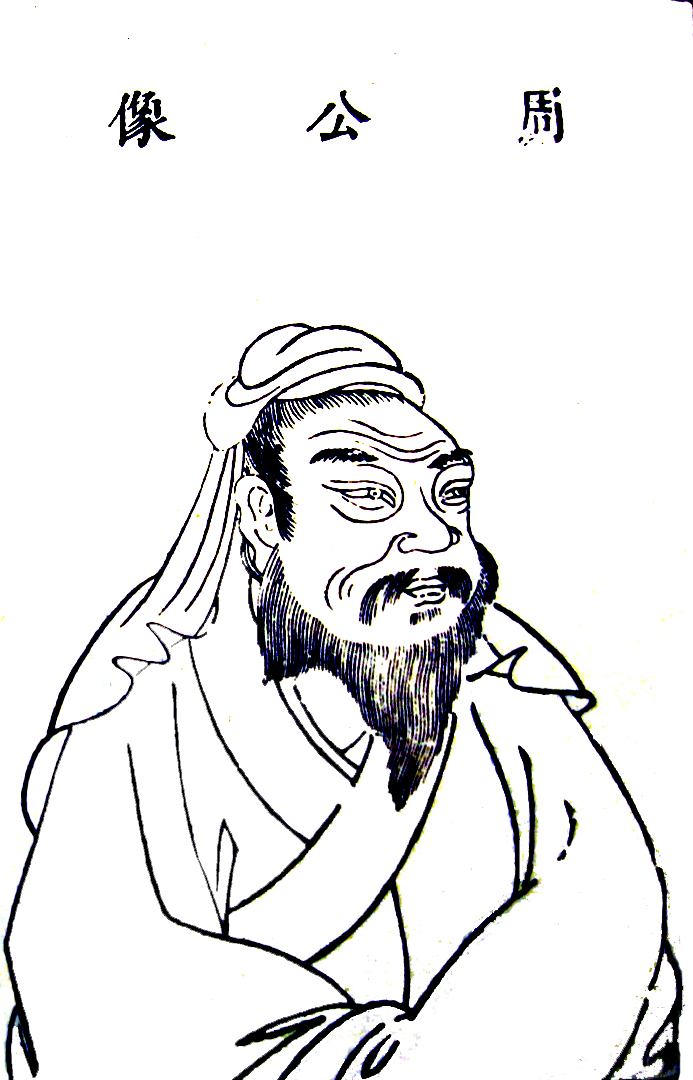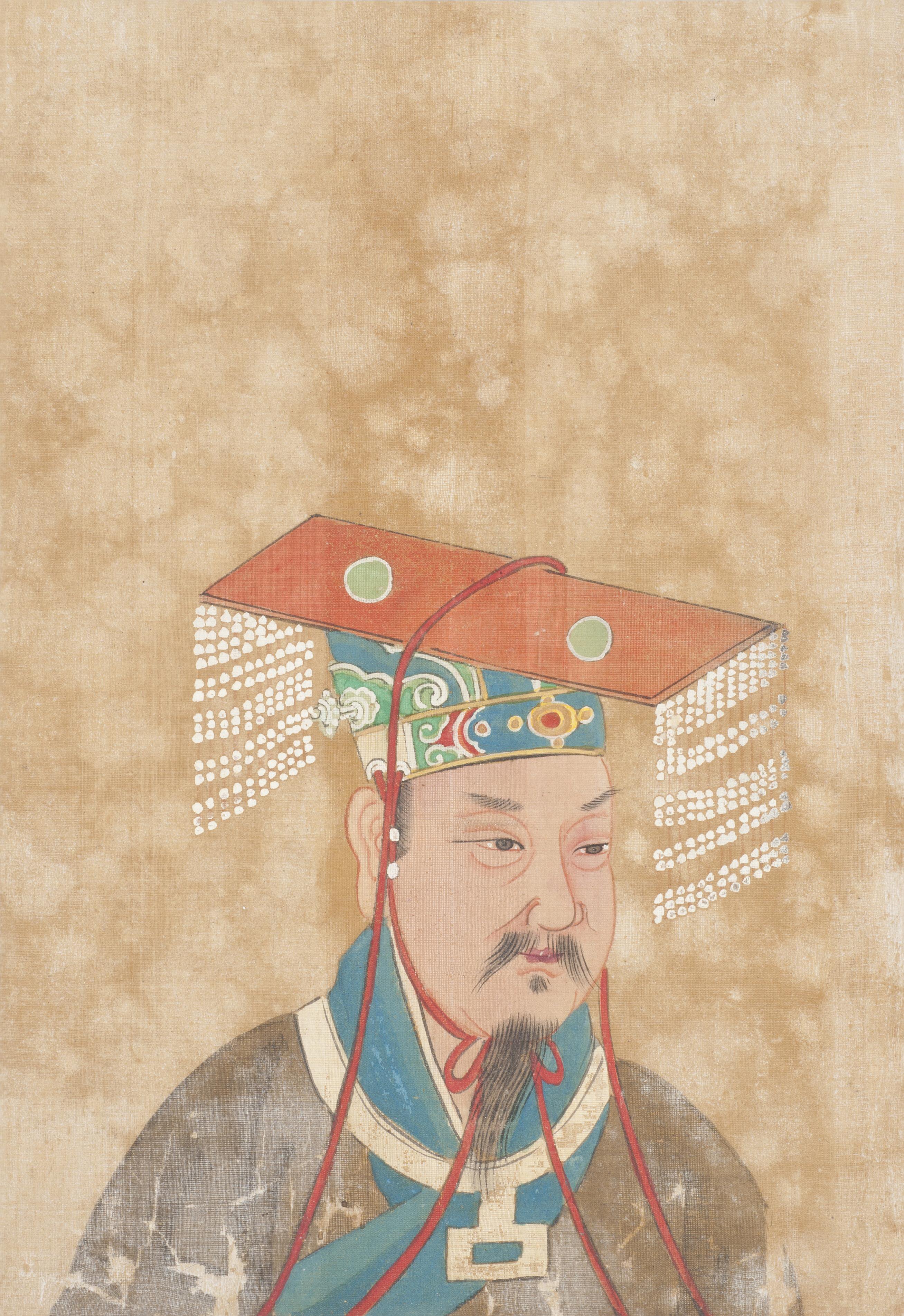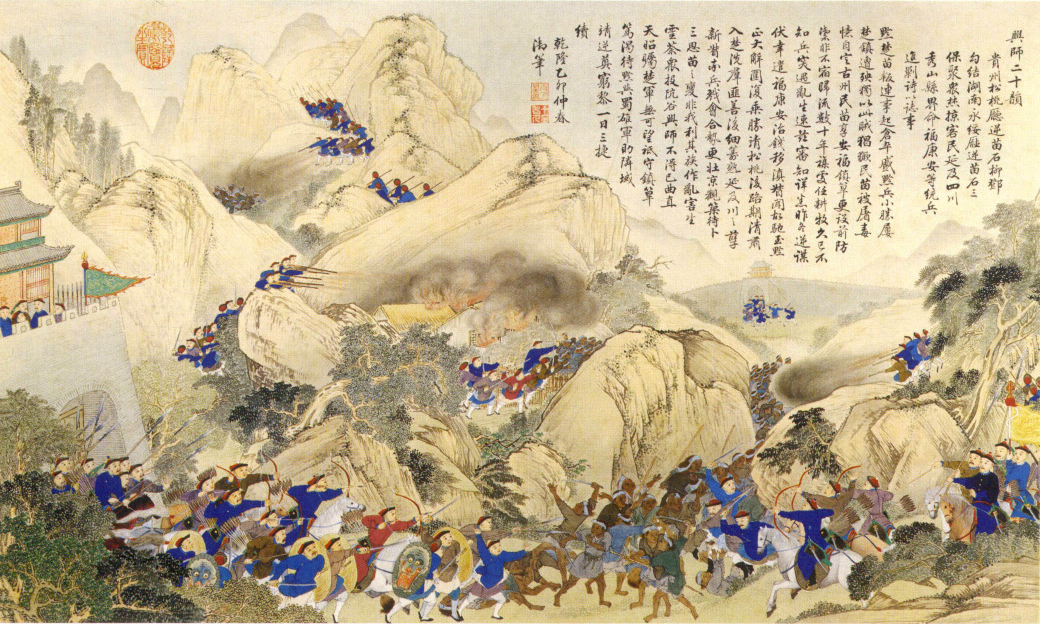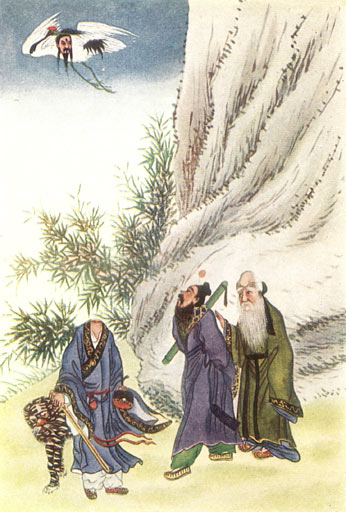|
Rebellion Of The Three Guards
The Rebellion of the Three Guards (), or less commonly the Wu Geng Rebellion (), was a civil war, instigated by an alliance of discontent Zhou princes, Shang loyalists, vassal states and other non-Zhou peoples against the Western Zhou government under the Duke of Zhou's regency in late 11th century BC. After the fall of the Shang dynasty, King Wu of Zhou had appointed his younger brothers Guanshu, Caishu and Huoshu as the "Three Guards" of the East to secure the newly conquered Shang lands. After his death and his young son King Cheng's coronation, King Wu's brother Dan, the Duke of Zhou, declared himself regent and took over the court. This aroused the anger of the Three Guards who suspected Dan of usurpation and believed that they should serve as regents. The Three Guards allied with many separatist eastern nobles, Shang loyalists under Prince Wu Geng, and several Dongyi and Huaiyi () states in rebellion. The Duke of Zhou then launched a second "eastern campaign" to put ... [...More Info...] [...Related Items...] OR: [Wikipedia] [Google] [Baidu] |
Zhou Dynasty
The Zhou dynasty ( ) was a royal dynasty of China that existed for 789 years from until 256 BC, the longest span of any dynasty in Chinese history. During the Western Zhou period (771 BC), the royal house, surnamed Ji, had military control over territories centered on the Wei River valley and North China Plain. Even as Zhou suzerainty became increasingly ceremonial over the following Eastern Zhou period (771–256 BC), the political system created by the Zhou royal house survived in some form for several additional centuries. A date of 1046 BC for the Zhou's establishment is supported by the Xia–Shang–Zhou Chronology Project and David Pankenier, but David Nivison and Edward L. Shaughnessy date the establishment to 1045 BC. The latter Eastern Zhou period is itself roughly subdivided into two parts. During the Spring and Autumn period (), power became increasingly decentralized as the authority of the royal house diminished. The Warring States ... [...More Info...] [...Related Items...] OR: [Wikipedia] [Google] [Baidu] |
Xu (state)
Xu (), also called Xu Rong () or Xu Yi () by its enemies, was an independent Huaiyi state of the Chinese Bronze Age that was ruled by the Ying family () and controlled much of the Huai River valley for at least two centuries. It was centered in northern Jiangsu and Anhui. An ancient but originally minor state that already existed during the late Shang dynasty, Xu was subjugated by the Western Zhou dynasty around 1039 BC, and was gradually sinified from then on. It eventually regained its independence and formed a confederation of 36 states that became powerful enough to challenge the Zhou empire for supremacy over the Central Plain. Able to consolidate its rule over a territory that stretched from Hubei in the south, through eastern Henan, northern Anhui and Jiangsu, as far north as southern Shandong, Xu's confederation remained a major power until the early Spring and Autumn period. It reached its apogee in the mid 8th century BC, expanding its influence as far as Zhejiang i ... [...More Info...] [...Related Items...] OR: [Wikipedia] [Google] [Baidu] |
East China
East China () is a geographical region in the People’s Republic of China, mainly consisting of seven province-level administrative divisions, namely the provinces (from north to south) Shandong, Jiangsu, Anhui, Zhejiang, Jiangxi, Fujian, and the direct-administered municipality Shanghai. The region was defined in 1945 as the jurisdiction area of the Central Committee's East China Bureau (), which was a merger politburo agency of the Shandong Bureau and the Central China Bureau previously established during the Second Sino-Japanese War. After the founding of the People's Republic of China, the region included all the aforementioned provinces except Jiangxi, which was previously considered part of South Central China before being reassigned in 1961. The East China Bureau was abolished in 1966 due to the Cultural Revolution, but in 1970 the fourth five-year plan redefined the region as the East China Coordinated Region (), which supported the logistics of the Jinan and Nan ... [...More Info...] [...Related Items...] OR: [Wikipedia] [Google] [Baidu] |
King Wu Of Zhou
King Wu of Zhou (; died ), personal name Ji Fa, was the founding king of the Chinese Zhou dynasty. The chronology of his reign is disputed but is generally thought to have begun around 1046 BCE and ended with his death three years later. King Wu was the second son of Ji Chang (posthumously King Wen) and Tai Si. In most accounts, his older brother Bo Yikao was said to have predeceased his father, typically at the hands of King Zhou of Shang, the last king of the Shang dynasty; in the '' Book of Rites'', however, it is assumed that his inheritance represented an older tradition among the Zhou of passing over the eldest son. (Fa's grandfather Jili had likewise inherited Zhou despite two older brothers.) Upon his succession, Fa worked with his father-in-law Jiang Ziya to accomplish an unfinished task: overthrowing the Shang dynasty. During the ninth year of his reign, Fa marched down the Yellow River to the Mengjin ford and met with more than 800 dukes. He constructed an ... [...More Info...] [...Related Items...] OR: [Wikipedia] [Google] [Baidu] |
Western Zhou
The Western Zhou ( zh, c=西周, p=Xīzhōu; 771 BC) was a period of Chinese history corresponding roughly to the first half of the Zhou dynasty. It began when King Wu of Zhou overthrew the Shang dynasty at the Battle of Muye and ended in 771 BC when Quanrong pastoralists sacked the Zhou capital at Haojing and killed King You of Zhou. The "Western" label for the period refers to the location of the Zhou royal capitals, which were clustered in the Wei River valley near present-day Xi'an. The early Zhou state was ascendant for about 75 years; thereafter, it gradually lost power. The former lands of the Shang were divided into Ancient Chinese states, hereditary fiefs that became increasingly independent of the Zhou king over time. The Zhou court was driven out of the Wei River valley in 771 BC: this marked the beginning of the Eastern Zhou period, wherein political power was wielded in actuality by the king's nominal vassals. Sources The Western Zhou are known from ... [...More Info...] [...Related Items...] OR: [Wikipedia] [Google] [Baidu] |
Shang Dynasty
The Shang dynasty (), also known as the Yin dynasty (), was a Chinese royal dynasty that ruled in the Yellow River valley during the second millennium BC, traditionally succeeding the Xia dynasty and followed by the Western Zhou dynasty. The classic account of the Shang comes from texts such as the '' Book of Documents'', '' Bamboo Annals'' and '' Shiji''. Modern scholarship dates the dynasty between the 16th and 11th centuries BC, with more agreement surrounding the end date than beginning date. The Shang dynasty is the earliest dynasty within traditional Chinese history that is firmly supported by archaeological evidence. The archaeological site of Yinxu, near modern-day Anyang, corresponds to the final Shang capital of Yin. Excavations at Yinxu have revealed eleven major royal tombs, the foundations of former palace buildings, and the remains of both animals and humans that were sacrificed in official state rituals. Tens of thousands of bronze, jade, ... [...More Info...] [...Related Items...] OR: [Wikipedia] [Google] [Baidu] |
List Of Rebellions In China
This is an incomplete list of some of the rebellions, revolts and revolutions that have occurred in China. Xia dynasty * The rebellion of Han Zhuo, a 20-year semi-mythological interregnum of the Xia dynasty, in which Han Zhuo murdered Xiang of Xia and installed himself as ruler until his defeat by Shao Kang and the restoration of the Xia. Zhou dynasty * Rebellion of the Three Guards (late 11th century BC) was a three-year rebellion of the Shang dynasty, Shang and three uncles of King Cheng of Zhou against their nephew and his regent, the Duke of Zhou. * Compatriots Rebellion (842 BC) was an uprising against King Li of Zhou, ending with the King's exile, establishing the interregnum Gonghe Regency until King Xuan of Zhou took the throne. Qin dynasty * The Dazexiang Uprising (; July – December 209 BC) was the first uprising against Qin rule following the death of Qin Shi Huang. Chen Sheng and Wu Guang were both army officers who were ordered to lead the ... [...More Info...] [...Related Items...] OR: [Wikipedia] [Google] [Baidu] |
Wu Geng
Wu Geng or Wugeng (Chinese language, Chinese: ''Wǔgēng''), a.k.a. ''Lùfù'', was an ancient Chinese people, Chinese Chinese nobility, noble who was the son of King Zhou of Shang, King Zhou, the last chinese king, king of the Shang dynasty, Shang. After his father executed Bigan by cutting out his heart, Wugeng fled to Feng, the capital of the Zhou state, together with his uncles Weizi and Weizhong to plead King Wu of Zhou for help. Shortly afterward King Wu attacked the Shang and defeated King Zhou at the Battle of Muye, thus establishing the Zhou dynasty. Wugeng was allowed to stay in Yin, the old Shang capital, and rule it as a princedom and a vassal lord to King Wu. After King Wu of Zhou, King Wu's death and the ascension of his young son King Cheng of Zhou, Cheng, Wugeng joined the Rebellion of the Three Guards, failed rebellion of the Three Guards against the regent Duke of Zhou. He in turn was joined by the "Dongyi, Eastern Barbarian" states of ancient China, states. The r ... [...More Info...] [...Related Items...] OR: [Wikipedia] [Google] [Baidu] |
Shu Du Of Cai
Cai Shu Du or Shu Du of Cai ( zh, c=, l=Du, oyalUncle of Cai), given name Du (), was the first ruler of the State of Cai. Du was the fifth son of King Wen of Zhou and his wife Taisi (). He had ten brothers and eight half-brothers. His elder brothers were Kao ( Boyi Kao), Fa (King Wu of Zhou), Xian ( Guan Shu), and Dan (the Duke of Zhou). He was given the fief of Cai by King Wu after the overthrow of the last Shang king, Zhou. Du's realm centered on present-day Shangcai, Henan. He and his brothers Guan Shu Xian and Huo Shu Chu (霍叔處) were known as the Three Guards, but when King Wu died and the Duke of Zhou assumed the regency for the young King Cheng, they rebelled along with Wu Geng Wu Geng or Wugeng (Chinese language, Chinese: ''Wǔgēng''), a.k.a. ''Lùfù'', was an ancient Chinese people, Chinese Chinese nobility, noble who was the son of King Zhou of Shang, King Zhou, the last chinese king, king of the Shang dynasty, Shan .... The Duke of Zhou was able to s ... [...More Info...] [...Related Items...] OR: [Wikipedia] [Google] [Baidu] |
Shu Xian Of Guan
Guan Shu Xian () was the first and only ruler of the Chinese state of Guan and was the younger brother of King Wu of Zhou. He was the third son of King Wen of Zhou, and one of the Three Guards responsible for overseeing the eastern lands of the newly-founded Zhou dynasty. Three years into the first reign, King Wu died of an illness and left his underage son, Song, as king. Thus Dan, the Duke of Zhou - who was the fourth son of King Wen - fearing that the kingdom might fall apart under an inexperienced king, took over government affairs as regent. This angered Guanshu Xian and the other two guards, who felt the Duke of Zhou had usurped the throne, and thus they joined Zi Wugeng, the son of the last king of Shang and nominal ruler of Yin, the old Shang capital, and began a rebellion against the regent. This was known as the Rebellion of the Three Guards. Following three years of war, the rebellion was crushed and Guanshu Xian, considered its main leader, was executed and the state ... [...More Info...] [...Related Items...] OR: [Wikipedia] [Google] [Baidu] |
Bo Qin
Bo Qin (), also known as Qin Fu (禽父), also known by his posthumous name as the Duke Tai of Lu (魯太公), was the founder of the Lu state, a dynastic vassal state of the Zhou dynasty. Born into the royal Ji family, he was the eldest son of Dan, the Duke of Zhou. Instead of inheriting his father's estate in Zhou, he was granted the newly established State of Lu centered at Qufu. He is thought to have ruled Lu from around 1042 to 997 BC. He was succeeded first by his son Duke Kao and then by Duke Yang, another of his sons. The main line of the Duke of Zhou's descendants came from Bo Qin's third son Yu (魚), whose descendants adopted the surname Dongye (東野). The Duke of Zhou's offspring held the title of Wujing Boshi (五经博士; 五經博士; ''Wǔjīng Bóshì''). Bo Qin was the ancestor of Mencius Mencius (孟子, ''Mèngzǐ'', ; ) was a Chinese Confucian philosopher, often described as the Second Sage () to reflect his traditional esteem relative to Conf ... [...More Info...] [...Related Items...] OR: [Wikipedia] [Google] [Baidu] |
Jiang Ziya
Jiang Ziya ( century BC – 11th century BC), also known by several other names, also known by his posthumous name as the Duke Tai of Qi, was the founding monarch of the Qi state. He was a military general and strategist who assisted King Wen of Zhou and King Wu of Zhou overthrow the Shang dynasty and establish the Zhou dynasty. Following their victory in the Battle of Muye, he continued to serve as a Zhou minister. He remained loyal to the regent Ji Dan (Duke Wen of Zhou) during the Rebellion of the Three Guards; following the Ji Dan's punitive raids against the restive Dongyi, Jiang was enfeoffed with the land of Qi. He established his seat at Yingqiu (in modern-day Linzi, Zibo, Shandong). He has been worshipped as a war god since the Han and, especially, Tang dynasties. He is also celebrated in Chinese literature, and is one of the main heroes in the Ming-era ''Investiture of the Gods''. Names The first ruler of Qi bore the given name Shang. The nobi ... [...More Info...] [...Related Items...] OR: [Wikipedia] [Google] [Baidu] |






